Sink drain: types, installation, problems
Which drain for the sink in the kitchen or bathroom is better to choose? Generally, what are they? How are fittings to connect a sink or washbasin to the sewer?
Does she have any typical problems? Let's try to figure it out.
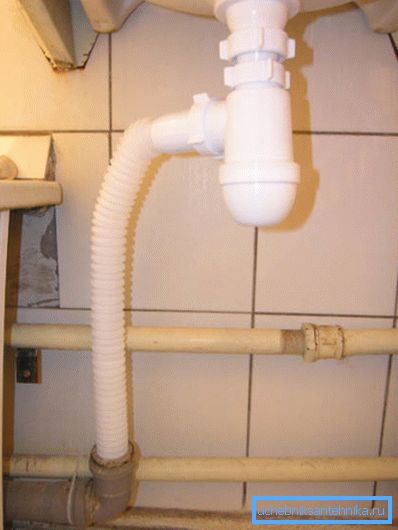
Functions
Let's start with why we need sink fittings.
She must:
- Provide coarse filtration of wastewater, catch large-scale garbage and food waste.
- To transport drains from the sink to the local sewage system.
- To guarantee the tightness of all connections - and the absence of leaks, and the impossibility of the flow of air from the sewer into the bathroom or kitchen space. The accompanying flavors are clearly useless.
There may be a number of additional options:
- Removable mesh for trash. They are equipped with many kitchen sinks with wide releases.
- Additional outlet for connecting the drain of the washing machine.
- Overflow, preventing overflow sink when clogged release.
Curiously, overflow in washbasins is often part of the sink itself. It is a cavity in faience or porcelain, connecting the hole in the upper part of the bowl with the release.
- Cork, when pressed overlapping drain. You can open it again by either pressing again or lifting the cork by the handle.
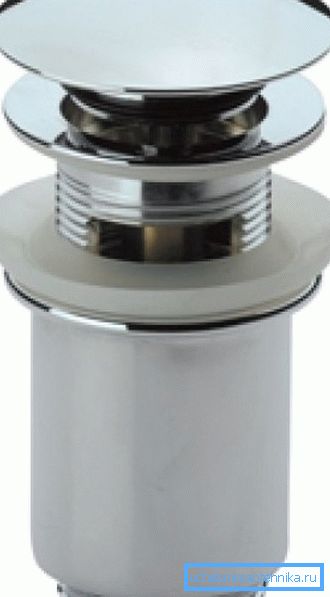
Execution options
Armature can vary in several ways.
Lattice
It can be a figured stainless steel plate with perforations, which is attached to the issue with a stainless screw, or a plastic divider.
Products of the first type have a much lower throughput: if you are used to washing dishes or washing, opening the water to full capacity, the sink will quickly overflow. In addition, small holes in the stainless steel grate will be clogged with the debris that would pass through the plastic divider without causing any harm.
But the stainless grille is much more aesthetic and durable, and the plastic darkens with time and becomes covered with inevitable scratches.
Siphon
Drain siphon for the sink can be found in three versions.
- Corrugated - it is simply a corrugated PVC pipe connecting the outlet to the sewer socket. The corrugated tube ends in a straight, smooth section with a diameter exactly corresponding to the diameter of the collapsible PVC sewage system, which makes it possible to connect it to the socket absolutely tightly.
The water seal is formed by laying the tube with a counter-tilt; in the desired position, it is fixed with a simple plastic latch.
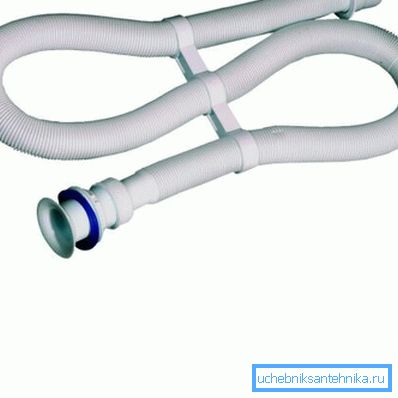
- Pipe siphon is a coil of plastic, made of stainless steel or brass (or, as is often incorrectly often said, of bronze) pipe. Bending and in this case is used to form a water seal. These products are more aesthetic compared to plastic corrugation and are used where fittings after installation remain visible.
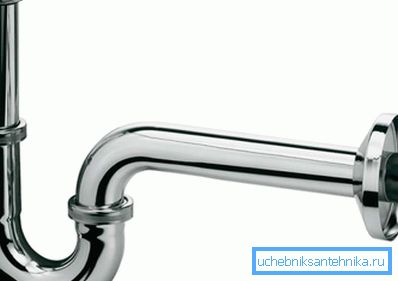
- Finally, bottle siphon it is supplied with a folding settler in which small heavy garbage gathers. The tightness of the connection of the tank of the sump with its bottom provides, as a rule, an annular rubber gasket.

Connection of siphon with sewage
Again, it is performed by a flexible corrugated tube or a stiff knee. The first option is much easier to install; in the second case, the tightness of the connection with the sewer bell has to be provided with a rubber cuff - an adapter.
Installation
Let's figure out how to assemble a drain system. In general, assembly instructions for drain fittings are usually attached by the manufacturer, but even in cases where there is none, installation rarely causes problems.
However, there are several subtleties:
- Thin ring gaskets, complete with stainless steel grilles of the outlets, are not placed under the grill, but under the sink. If you put the gasket inside the bowl, then water will always be on its bottom.
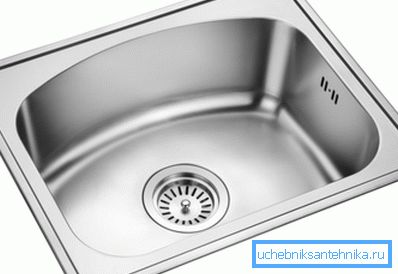
- The plastic lattice is often completed with the same gasket that is intended for installation inside the bowl. If you care about aesthetics - replace it with a gasket cut to size from thick (not less than a centimeter) microporous rubber, which can be safely placed under a washstand and pressed with a nut.
An important point: between the nut and the microporous gasket, a plastic washer is necessarily put on the release. Without it, the nut will tear the soft rubber.
- Tightening the screw on the metal grating release, do not overdo it. As a rule, it attracts the release of the nut, which is fixed in the center of release with thin plastic legs.
- If the bottom of the bottle siphon flows during assembly, discard the standard gasket and reel it with a FUM tape or a strip cut from a thick plastic bag. At least not the worst result will give a polymer sealing thread (Tangit Unilok and its analogs); but its price is noticeably higher than that of the FUM tape, and the expense will be quite significant.
- The tightness of the connections of the siphon with the knee and the release is most often provided by an annular gasket with a conic section. It is put on the tube after the cap nut with the narrow part of the cone of section to the socket. When assembling, the gasket edge should enter the socket around the entire circumference: in this case, the nut is guaranteed not to hem the rubber.
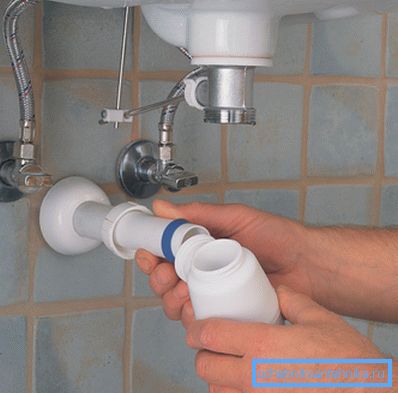
- A broken plastic knee can be quickly repaired by melting the edges of the plastic tube over the gas stove and connecting them. After this operation, it is advisable to try to remove the bur (melt squeezed into the pipe): it will begin to collect pollution and may sooner or later lead to clogging.
Materials and prices
The prices for drain fittings depend equally on the manufacturer and material. As in many other sectors of the market, German and Italian products are listed above; the golden mean is goods of Russian, Ukrainian and Belarusian origin. For products from China, an unpredictable quality is typical: in the same price range, you can find very high-quality fittings and fierce horror.
How does the material of the reinforcement affect the price? Here are some items from the assortment of the famous Ukrainian store of building materials.
| Valve Name | Material and Type | Retail cost, rubles |
| Solo Plast Economy G0015 | PVC corrugated | 95 |
| Solo Plast L1000 | Chrome-plated brass bottle | 1060 |
| Viega 366681 | Stainless steel bottle with cork | 1270 |
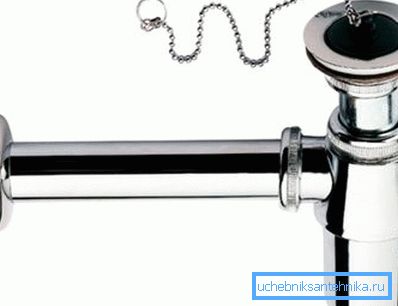
Problems and solutions
It is probably worth mentioning the most typical problems of drain fitting kits and how to fix them with your own hands.
The main problem - the water that stopped in the sink.
What if this happened in your home?
- Inspect the exhaust grille. Hair, pet hair and food waste often completely clog up its openings.
- Open the bottle siphon by unscrewing its bottom. Delete the contents.
Warning: if you are not a secret admirer of foul-smelling puddles on the floor, it is best to perform an autopsy over a wide basin.
- If these operations did not help - remove the knee or the corrugated tube and shake out the fat stuck on the walls. It is he who most often causes a blockage in the kitchen.

Slightly more rare trouble - to flow from under release.
It can be caused by accidental displacement of the siphon or a gasket that has been dried out with a long absence of dismantling
- Gently, without undue effort, tighten the release.
- If this does not work, replace the gasket with an analogue. It is easy to find in any plumbing store or just cut from a car or bicycle camera.
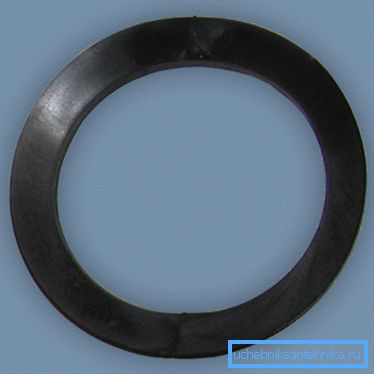
Conclusion
We sincerely hope that this material will help the reader in solving small household problems. As usual, the video in this article contains additional thematic information.
Successes!